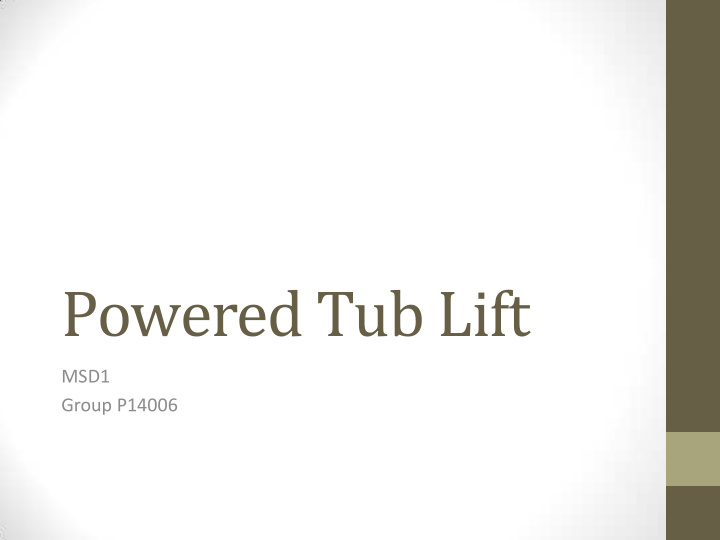



Powered Tub Lift MSD1 Group P14006
Agenda • Introductions • Project Overview • Problem Statement & Deliverables • Stakeholder(s) • Use Scenarios • Operations Break Down • Customer Requirements • Engineering Requirements • Project Plan • Benchmarking • Risk Assessment • Conclusions
Introductions Name Major/Role Amos Baptiste Industrial & Systems Engineer/Team Leader Jeremy Czeczulin Mechanical Engineer Andrew Hughes Mechanical Engineer Richard Prilenski Mechanical Engineer
Current State • Current device is not stable • Client feels unsafe • Broken arm rest on left side due to tub side shelf • Current model not in production • Parts have been replaced/fixed due to wear • Parts that do still work do not always operate properly • User has difficulty accessing chair
Desired State • Device has a stable base and build • Device is easy to access • Provide leg lifts to assist tub entry and exit • Easy to operate • Reclining features • Transportable • Meets requirements to satisfy the 10 th -70 th percentile of men and women, accommodating as many disabilities as possible.
P14006 Problem Statement • Bathtub lift – a device that provides assistance to an individual with physical disabilities, including limited balance, coordination, or mobility • Can reduce the difficulties of raising and/or lowering an individual into the tub by utilizing a powered seat and a simple control module • As population grows the number of aged individuals will greatly increase making demand for assist devices increase • Project motivation – Theresa Loce • Improve the current design • Current device does not meet her needs • Powered lift that is sturdy, comfortable, easy to use/clean, makes minimal noise, and takes into account physical limitations of user • Ultimate goal – user maintains autonomy and privacy
Project Deliverables • Effectively assist the user for bathing purposes • Device is easy to access from starting position • Minimized operating time • Provide a comfortable and supportive seating area • Accessible to 10 th -70 th percentile for both genders, regardless of age • Reasonably lightweight and portable, able to be transported
Stakeholder(s) • Primary Customer : Theresa Loce • Contact: 585-647-2329 • Secondary Customer (s) : Wheel chair users/handicap public & Elizabeth DeBartalo, Hospitals (RGH), Nursing Homes, suppliers/vendors, & individuals recovering from knee surgeries. • Contact: eademe@rit.edu • Faculty Guide : Art North • Contact: ajnddm@rit.edu • Sponsor (financial support): RIT & Theresa Loce
Use Scenarios • Bathtub lifts are effective for many worst case scenarios for the disabled and elderly people. However one critical issue remains, ease of access to the bathtub lift. • Due to individuals’ mobility disabilities, they often have a hard time being able to position themselves on the seat of the lift. • Issues such as slipping or periods of instability may occur to the individual needing to get in the actual tub before lowering the lift. • Individuals’ confidence are decreased due to uneasy feelings of being able to access the bathtub lift.
Operations Break Down
Customer Requirements
Engineering Requirements
Engineering Matrix
Project Plan (WK 4-6)
Benchmarking • Current Models: • Maximum weight supported 200-375 lbs • Uses suction cups for stability • Uses a waterproof hand remote • Powered by a rechargeable battery • Minimum lift height range 2.5” - 5” • Maximum lift height range 17” - 21” • Product total weight 19-27.5 lbs • Around 7 lifts per battery charge • Duration of Stroke: Up-50s Down-35s
Risk Assessment • Ensure user does not fall/slip off device • Moderate the water temperature • Water power supply inconsistent – psi level jump due to drop in water pressure • Electric power supply inconsistent – charge from battery may not be sufficient to operate device when running low • Device does not fail under loading – must be able to lift well over the minimum requirement • Not being able to fulfill requirements of broad user base (height/weight differences) • Fixture dimensions – not able to fit in tub • Safety of user’s legs – when fixture is lowering, allow adequate clearance, and also while moving user out of tub. • Transfer from starting position to the device – possible falling injury
Phase I - Retrospective • Things we have learned as a team: • Understanding each others’ strengths and weaknesses. • Assigning roles according to ones’ strengths. • Proper communication to minimize wasted time. • Planning ahead of time to effectively utilize given time the whole team is available. • Take project one step at a time, do not overlook detail that is critical to the customer. • Understand each others’ ideas and as a team choose the best ones to ensure best results.
Questions?
Recommend
More recommend